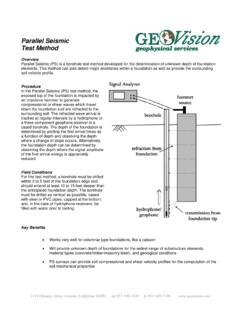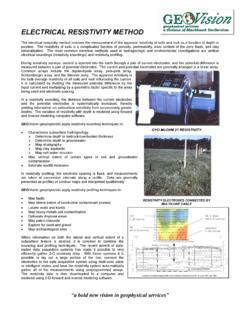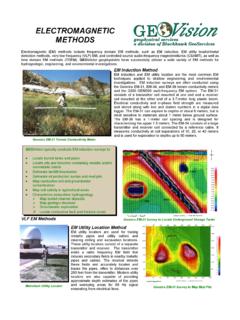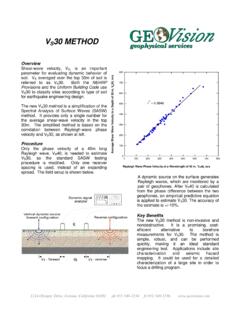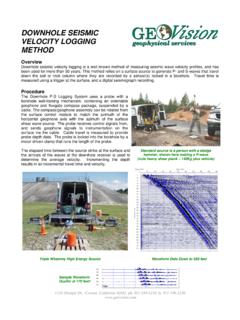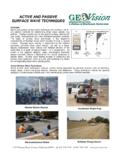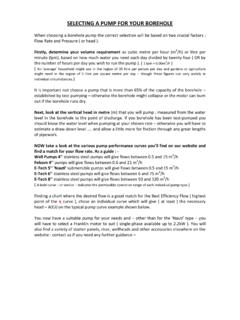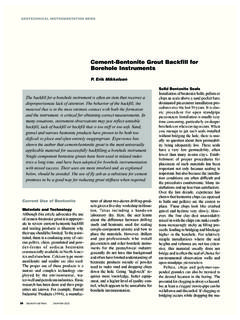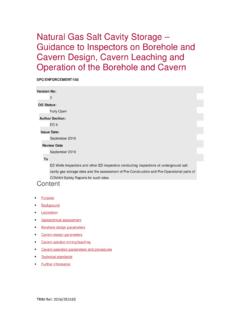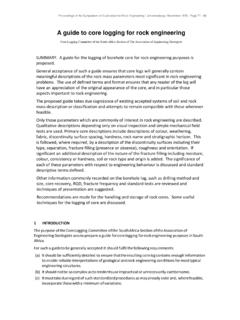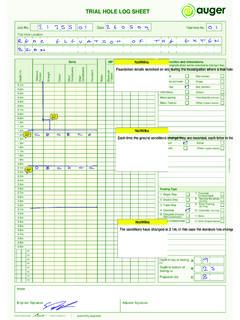Transcription of BOREHOLE TELEVIEWER LOGGING METHODS - GEOVision
1 BOREHOLE TELEVIEWER LOGGING METHODS Overview BOREHOLE TELEVIEWER LOGGING tools are used to obtain oriented images of BOREHOLE cores when core recovery is difficult, costly, or otherwise not available. Two different METHODS or technologies are available: the first uses the acoustic signal from a rotating sonar transducer and is called an acoustic TELEVIEWER . The second uses a high resolution digital color camera with a light source and is called an optical TELEVIEWER . Both METHODS utilize a built-in fluxgate magnetometer to orient the image with respect to magnetic north. The resulting data offers the unique ability to present the core either as a wrapped image, showing an external view of the core as if it were laying on its side; or as an unwrapped image, looking out from the center of the BOREHOLE .
2 One popular visual data display option is the projection of features onto an imaginary core that can be rotated and viewed from any orientation. Further analysis allows void and joint data to be presented in terms of depth, direction of dip (with respect to North), dip angle, and strike. High-Resolution Acoustic TELEVIEWER (HiRAT) The HiRAT is the latest Robertson Geologging (RG) development in acoustic BOREHOLE imaging and replaces the previous BOREHOLE TELEVIEWER probe (BHTV). It provides high-resolution, oriented images of the BOREHOLE walls presented in pseudo-color . The probe uses a fixed acoustic transducer and a rotating acoustic mirror to scan the BOREHOLE walls with a focused ultrasound beam. The amplitude and travel time of the reflected acoustic signal are recorded simultaneously as separate image logs.
3 Features such as fractures reduce the reflected amplitude and often appear as dark sinusoidtraces on the log. The travel-time log is equivalent to a high-precision 360-arm caliper and shows diameter changes within open fractures and 'break-outs'. Directional information is also recorded and used to orient the images in real time. al The HiRAT includes many new features such as automatic optimization of head rotation speed according to BOREHOLE diameter, cable speed and desired resolution. A new design of acoustic transducer provides improved image focus and resolution compared to the previous BHTV probe. Optical TELEVIEWER (OPTV) Similar to the acoustic TELEVIEWER but using visible light optics, the OPTV probe provides a continuous, detailed and orientated 360 true color image of the BOREHOLE walls using a unique optical imaging system.
4 This can be rapidly interpreted, using data from the internal orientation module, to obtain a complete feature analysis that includes dip, strike, frequency and fracture aperture. 1124 Olympic Drive, Corona, California 92881, ph. 951-549-1234, fx. 951-549-1236 1124 Olympic Drive, Corona, California 92881, ph. 951-549-1234, fx. 951-549-1236 Data Analysis RG-DIP, the RG image interpretation package, offers manual and automatic feature recognition options. Feature orientations (dip/strike and azimuth) are automatically calculated. Display options include stereographic projections of zone axes, orientation frequency plots and 'synthetic cores' for comparison with real core data. The last option is invaluable for orientating core samples, particularly in the case of incomplete recovery. Applications Applications include: Fracture identification and orientation Stratigraphic studies Local stress studies (break-out) Core orientation Comparison of METHODS The optical TELEVIEWER offers a big advantage and attraction for geologists since it images the natural rock colors.
5 It s like seeing the actual core. Otherwise, from the standpoint of mapping the orientation and angles of the cracks, there is no advantage at all. The optical TELEVIEWER requires clear fluid, or an empty, clean BOREHOLE . On the other hand, the acoustic TELEVIEWER requires BOREHOLE fluid. The acoustic TELEVIEWER is more reliable for a wider variety of applications, because it is often easier to use mud to keep fluid in the hole than to either flush the hole clean, or empty it, or wait until the fluid clears up. Further, the HiRAT can more easily detect the fine fractures. Finally, we can log with the HiRAT immediately after doing the seismic velocity PS Suspension LOGGING in the mud BOREHOLE without waiting to flush and clean the hole (no additional mobilization). Key Benefits BOREHOLE TELEVIEWER data is superior for several reasons: Will augment, and in some cases replace, expensive coring with its associated problems of incomplete core recovery Provides a digital image of the core that can be stored on electronic media beats going to the warehouse to look at the core in boxes Offers much more information than a conventional BOREHOLE television survey, including a map of the orientation angle relative to north, and a dip angle at a measured depth, of fractures that pass through the core.
6 An acoustic TELEVIEWER does not depend on clean fluid, as it can acquire data through drilling mud Both tools provide a BOREHOLE deviation log The HiRAT provides caliper data IMPORTANT NOTES: 1. Neither TELEVIEWER method will give seismic velocity data for the formation. The TELEVIEWER signals stop at the BOREHOLE wall. For seismic velocity LOGGING please see GEOV ision s brochure for the PS Suspension LOGGING Method. 2. These tools are designed for rock coreholes. Neither method offers much over a television (CCTV) survey in soils, since the drilling process usually disturbs the soil at the surface of the BOREHOLE wall and fractures cannot be resolved. That said, if you have a BOREHOLE with soil over rock, and you are LOGGING the BOREHOLE anyway, the TELEVIEWER can image transitions in the soils.
7 3. If an optical TELEVIEWER log is required, and the rock portion of a BOREHOLE must be flushed clean, it is recommended that PVC casing be used to keep the soil portion (if any) of the BOREHOLE open.
